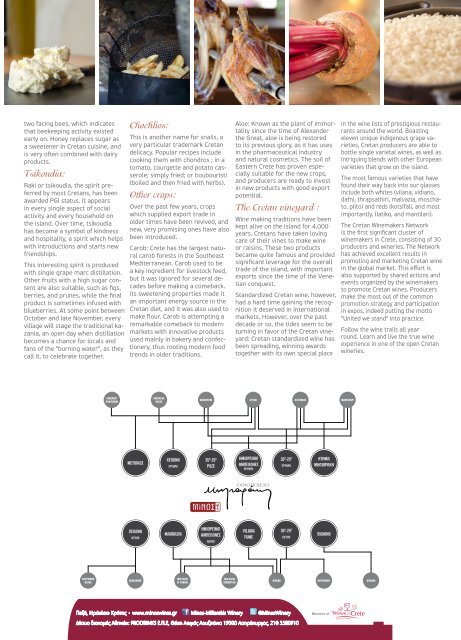ByBus Summer 2015
You also want an ePaper? Increase the reach of your titles
YUMPU automatically turns print PDFs into web optimized ePapers that Google loves.
two facing bees, which indicates<br />
that beekeeping activity existed<br />
early on. Honey replaces sugar as<br />
a sweetener in Cretan cuisine, and<br />
is very often combined with dairy<br />
products.<br />
Tsikoudia:<br />
Raki or tsikoudia, the spirit preferred<br />
by most Cretans, has been<br />
awarded PGI status. It appears<br />
in every single aspect of social<br />
activity and every household on<br />
the island. Over time, tsikoudia<br />
has become a symbol of kindness<br />
and hospitality, a spirit which helps<br />
with introductions and starts new<br />
friendships.<br />
This interesting spirit is produced<br />
with single grape marc distillation.<br />
Other fruits with a high sugar content<br />
are also suitable, such as figs,<br />
berries, and prunes, while the final<br />
product is sometimes infused with<br />
blueberries. At some point between<br />
October and late November, every<br />
village will stage the traditional kazania,<br />
an open day when distillation<br />
becomes a chance for locals and<br />
fans of the "burning water", as they<br />
call it, to celebrate together.<br />
Chochlios:<br />
This is another name for snails, a<br />
very particular trademark Cretan<br />
delicacy. Popular recipes include<br />
cooking them with chondros ; in a<br />
tomato, courgette and potato casserole;<br />
simply fried; or boubouristi<br />
(boiled and then fried with herbs).<br />
Other crops:<br />
Over the past few years, crops<br />
which supplied export trade in<br />
older times have been revived, and<br />
new, very promising ones have also<br />
been introduced.<br />
Carob: Crete has the largest natural<br />
carob forests in the Southeast<br />
Mediterranean. Carob used to be<br />
a key ingredient for livestock feed,<br />
but it was ignored for several decades<br />
before making a comeback.<br />
Its sweetening properties made it<br />
an important energy source in the<br />
Cretan diet, and it was also used to<br />
make flour. Carob is attempting a<br />
remarkable comeback to modern<br />
markets with innovative products<br />
used mainly in bakery and confectionery,<br />
thus rooting modern food<br />
trends in older traditions.<br />
Aloe: Known as the plant of immortality<br />
since the time of Alexander<br />
the Great, aloe is being restored<br />
to its previous glory, as it has uses<br />
in the pharmaceutical industry<br />
and natural cosmetics. The soil of<br />
Eastern Crete has proven especially<br />
suitable for the new crops,<br />
and producers are ready to invest<br />
in new products with good export<br />
potential.<br />
The Cretan vineyard :<br />
Wine making traditions have been<br />
kept alive on the island for 4,000<br />
years. Cretans have taken loving<br />
care of their vines to make wine<br />
or raisins. These two products<br />
became quite famous and provided<br />
significant leverage for the overall<br />
trade of the island, with important<br />
exports since the time of the Venetian<br />
conquest.<br />
Standardized Cretan wine, however,<br />
had a hard time gaining the recognition<br />
it deserved in international<br />
markets. However, over the past<br />
decade or so, the tides seem to be<br />
turning in favor of the Cretan vineyard:<br />
Cretan standardized wine has<br />
been spreading, winning awards<br />
together with its own special place<br />
in the wine lists of prestigious restaurants<br />
around the world. Boasting<br />
eleven unique indigenous grape varieties,<br />
Cretan producers are able to<br />
bottle single varietal wines, as well as<br />
intriguing blends with other European<br />
varieties that grow on the island.<br />
The most famous varieties that have<br />
found their way back into our glasses<br />
include both whites (vilana, vidiano,<br />
dafni, thrapsathiri, malvazia, moschato,<br />
plito) and reds (kotsifali, and most<br />
importantly, liatiko, and mantilari).<br />
The Cretan Winemakers Network<br />
is the first significant cluster of<br />
winemakers in Crete, consisting of 30<br />
producers and wineries. The Network<br />
has achieved excellent results in<br />
promoting and marketing Cretan wine<br />
in the global market. This effort is<br />
also supported by shared actions and<br />
events organized by the winemakers<br />
to promote Cretan wines. Producers<br />
make the most out of the common<br />
promotion strategy and participation<br />
in expos, indeed putting the motto<br />
"United we stand" into practice.<br />
Follow the wine trails all year<br />
round. Learn and live the true wine<br />
experience in one of the open Cretan<br />
wineries.
















